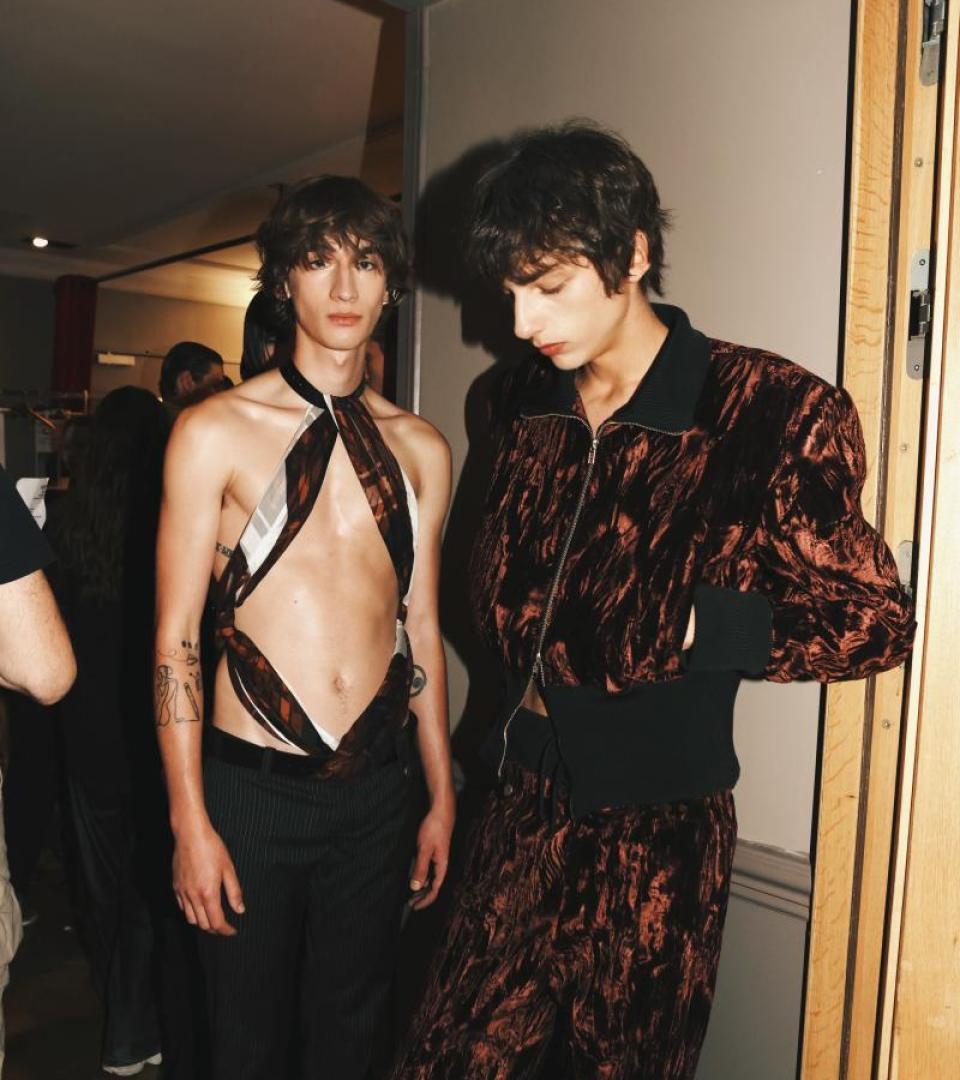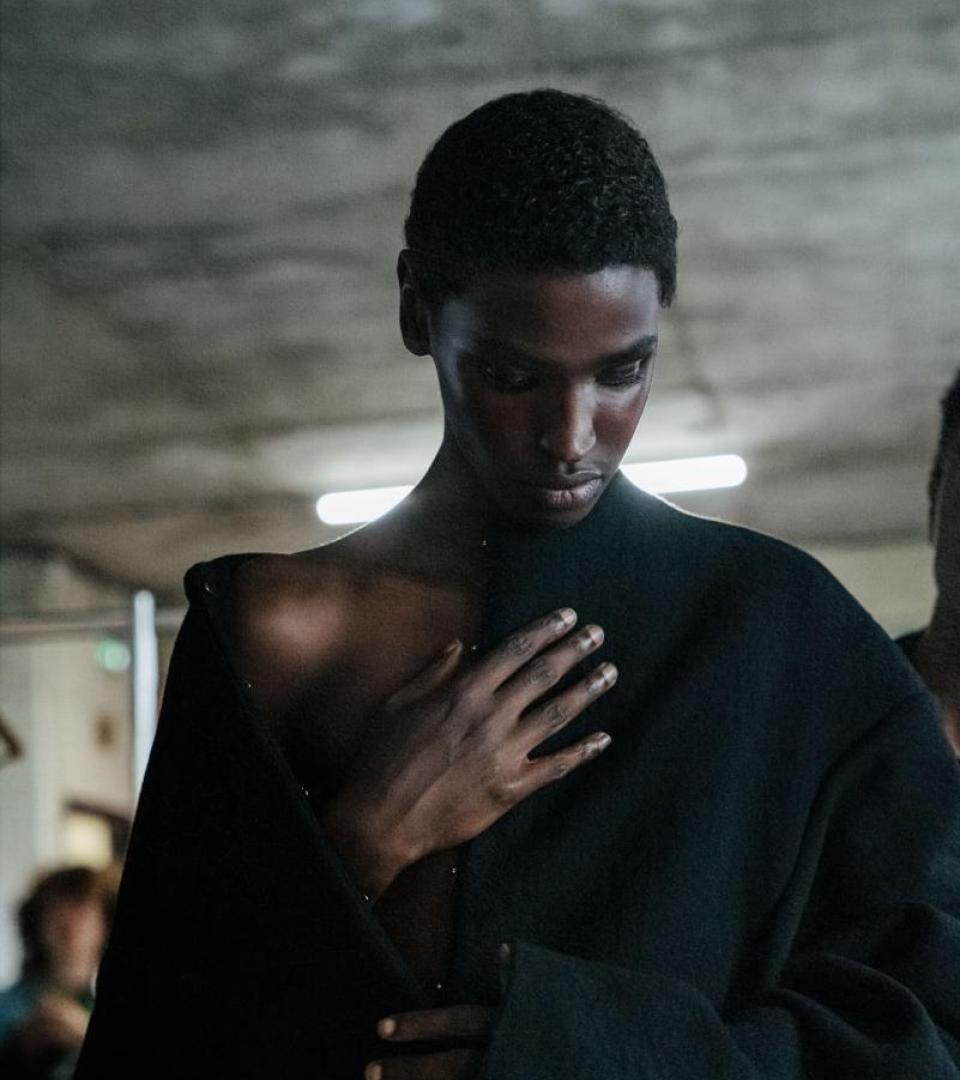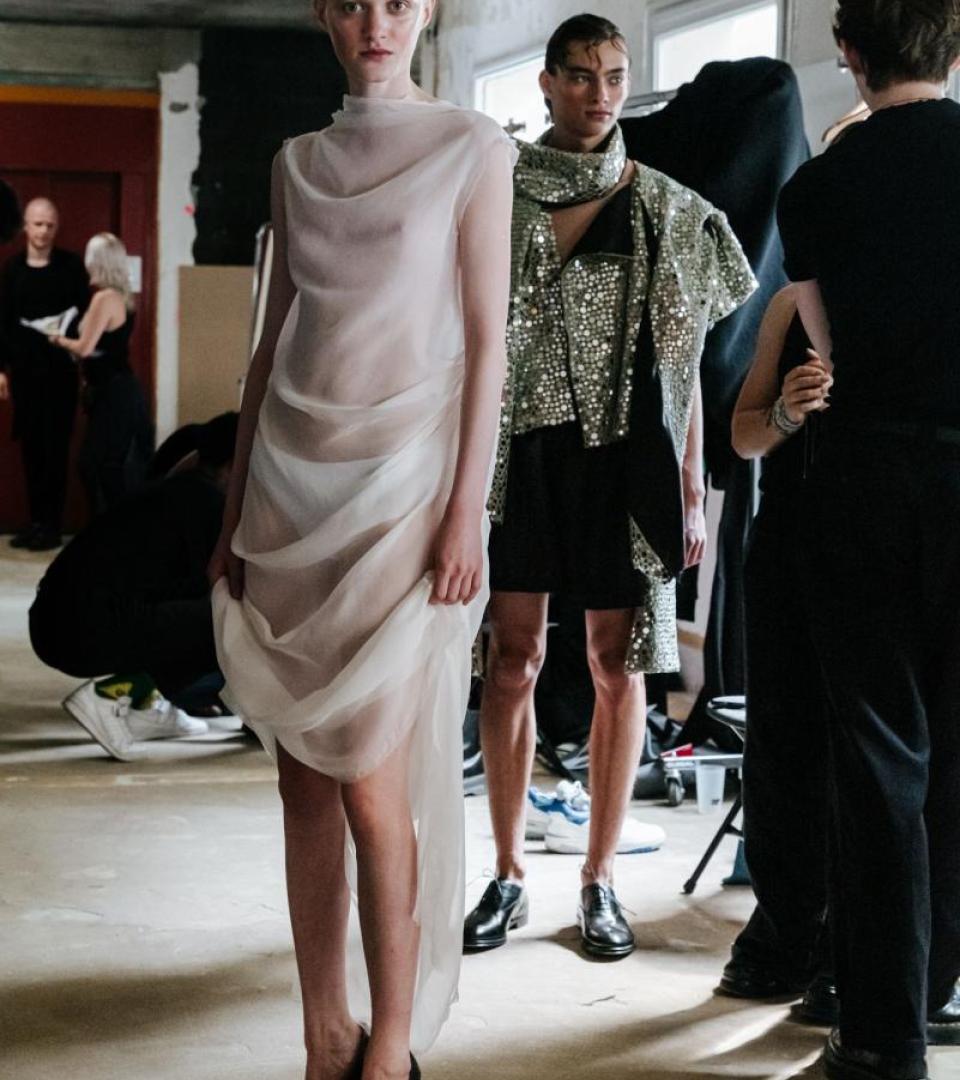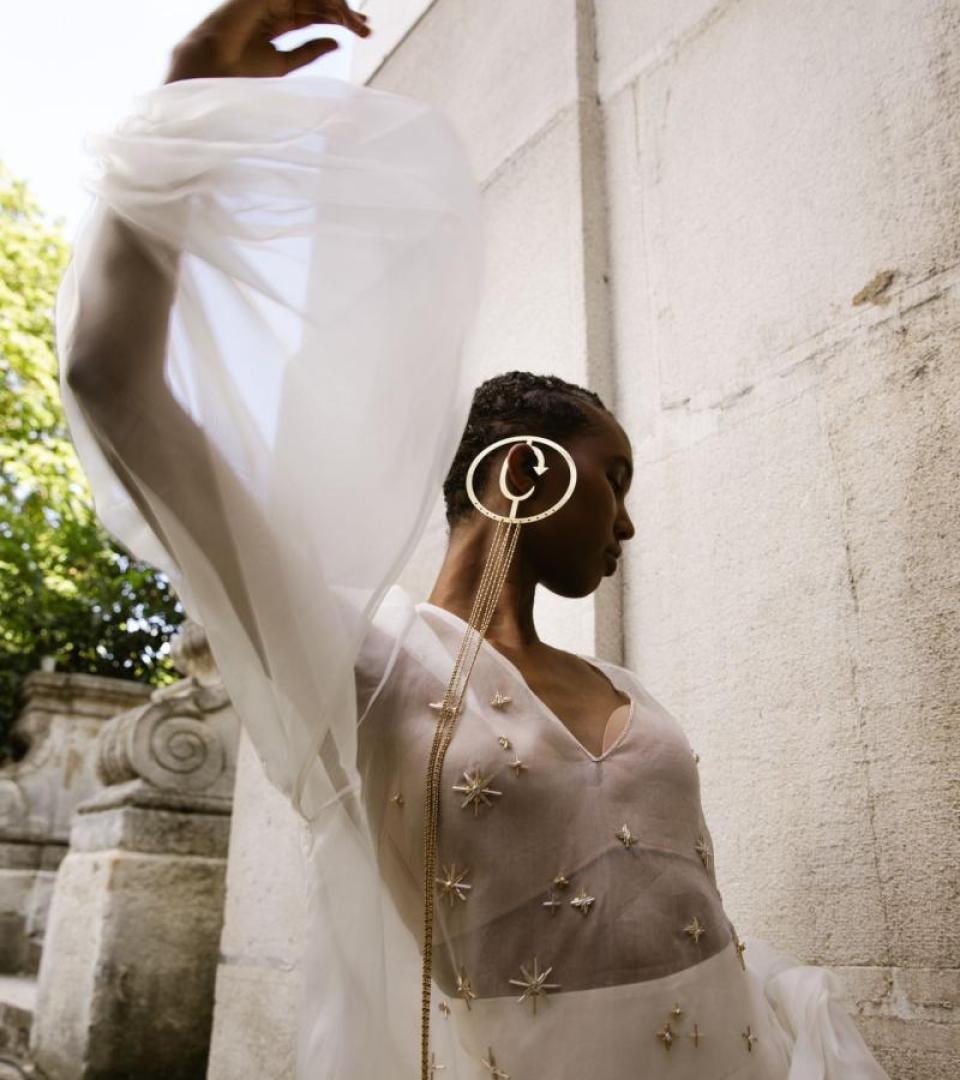Olivier Saillard: “I'm drawn to what fashion holds of the faded, the hidden. The clothes we choose to wear guide and narrate us.”
There once was a little boy, huddled against clothes piled up in an attic, who would go on to become director of the Palais Galliera and then the Azzedine Alaïa Foundation. He has authored nearly 250 exhibitions, dozens of books, and some thirty performances, including “Moda Povera V – Les vêtements de Renée,” running at the Grand Palais from July 10 to 13. A tribute to those very same clothes that protected him as a child, and a striking demonstration that fashion bears the imprint of the living, the memory, and the intimate.
In his office at the Azzedine Alaïa Foundation, which he has directed since 2017, the shelves are packed with books galore. Fashion books, art books, some mixing both worlds. And he himself is quite a mix, of softness and precision. A few obstinate quests run through his career: seeking the right word, poetry in vintage clothes, and Madame Grès, whom he can't help but spotlight whenever he gets the chance. What's most striking about this hard worker is that he has kept intact that sense of wonder that belongs to childhood. Mention a designer he admires and he comes alive. He has carried this spirit into his numerous projects – exhibitions, books, performances – everywhere he has been given the reins. At the Marseille Fashion Museum, which he directed from the age of 27 and where he staged “L'homme-objet,” the first exhibition dedicated to menswear. At the Musée des Arts Décoratifs, where he celebrated Yamamoto, Balenciaga, Lacroix. At the Palais Galliera, where he notably showcased Madame Grès's sculptural talent. Today, he is both "artistic, image and culture director" at the shoemaker Weston – who more fitting than a fashion historian to steer a House with monumental heritage? – and director of the Azzedine Alaïa Foundation. There he scrutinises the great couturier's work with the culture of a curator, the rigour of an archaeologist and the loyalty of a close friend. A remarkable journey that built itself naturally, though there was indeed someone who sensed it very early on: “At 18, I had sent my drawings to Christian Lacroix. I wanted to do fashion illustration, but I was self-taught. In his beautiful handwriting, he had replied that with that kind of passion, I will pursue a career in fashion. He concluded with 'What must happen to you will happen.' That kept me going.” Christian Lacroix, playing prophet as only he could.
“I felt we hadn't invented the fashion museum we had the right to have, so we were going to try.”
When Saillard began creating performances twenty years ago, his objective was “to introduce life into museums.” In 2005, even before assuming the direction of the Palais Galliera, he staged his very first performance “with a friend, Violeta Sanchez, who was a model for Saint Laurent.” He then presented, for the first time for himself as much as for others, a runway show of words. “She described garments, as they used to do in couture salons, but there were no dresses.” This planted the seeds for the "Moda Povera" series, which he launched in 2018. The reference is obvious: arte povera, the Italian artistic movement of the 1960s that advocated a return to simplicity in materials and techniques, involving the spectator within the work itself. A way for him to rediscover fashion's fundamentals: craftsmanship and the creation of emotions. This new series began with Martine Lenoir and Axelle Doué, both of whom had worked for Madame Grès, as seamstress and model respectively. Together, they transformed T-shirts found online – “some T-shirts cost less than their delivery fees.” – by sculpting them with draping, cuts and seams. “I told myself that Moda Povera would be an enterprise where we bring people together, former seamstresses who were part of ateliers, independent seamstresses, younger people, and it continued.” After T-shirts, he tackled “men's suits from Kiabi, then shirts. I developed a taste for making these garments, for transforming them. I find that this too is working on fashion history.”
“With Moda Povera V, it became obvious that there was nothing to sell in my performances. There is only an educational project, a collective project of history, of intimate history.”
This poetic enterprise culminates in its fifth chapter: “Renée's Clothes.” He could have titled it “My Mother's Clothes” but that would have limited the woman to her maternal function. Using her first name tells her wholeness. And this is precisely what our clothes do: they tell our story. “If we each opened our wardrobes, we would have enough to tell who we are. I've often thought that clothes hanging there are like books on a shelf, spine-side out. I'm drawn to what fashion holds of the faded, the hidden. Even when we put on our clothes randomly, they guide and narrate us.”
For someone who has devoted his life to archiving pieces from the past, confronting his own history proves different. “My mother died in 2020, during Covid, not from Covid. I had trouble going back to her clothes. I find it very hard, almost harder than death itself, to clean up the past.” Instinctively, he emptied the boxes, rediscovered his mother through her wardrobe. “There were 40 black trousers, I don't know why. She was redheaded and there were also colours like mauve, green, which suit particularly well.” Some pieces catch his attention more, because they guard memories, like “this Daniel Hechter dress she had bought for my sister's wedding.” He finds coats and decides to turn them into capes. “I was looking a lot at Schiaparelli and Charles James capes. So, we removed the sleeves from all the coats. As if we had removed wings. There is in the transformed clothes a form of diving into silence.”
He would already nestle into these very same clothes as a child. “We used to put clothes we no longer wore up in the attic, like my mother's 1950s dresses that she'd stopped wearing by the '70s. When you're a kid, twenty years back feels as distant as the eighteenth century. Spending time in that attic as a child instilled in me this taste for the past. I loved that poetry.” Sometimes he would even empty everything out, arrange the clothes on display, until he'd created a shapeless mass to lose himself in. “My mother would yell that she'd just folded everything. I'd roll around in clothes from the past.” That's surely where it all began, this urgency to stage clothing. “I think back to Christian Boltanski's installations, with those mountains of clothes. They took on a much more symbolic and frightening charge. It's death made manifest. I felt I was closer to that, in my natural inclination.”
Diving back into these boxes, he rediscovers among other things a copy of a very unique fashion magazine, “Le Grand Couturier,” that he had made himself when he was 12. He had written the articles, sketched out collections. “I had made a drawing to explain how to stage a fashion show. I had drawn the runway, sketched a mock model and specified the number of steps, the pose at the end of the catwalk, like a technical sheet.” He signs all these articles with his first name and invents different last names, one foot in fiction, the other in reality. “It reassured me that it said Olivier and it reassured me that there were different names.”
“I always make sure I can create without being driven by economics. I'd always want to be like a writer who, even without a computer, always has his notebook and pen to work with. I need to be able to create, regardless of my means.”
At the Grand Palais, he co-signs his performance with Axelle Doué, Zoé Guedard and Gaël Mamine. “What I love about Moda Povera is this collective creation system that exists in contemporary dance. It's collective creation. I'd be incapable of transforming clothes without Axelle. It's seeing the piece on her, the way she moves, that makes things come alive. Gaël Mamine has been my partner for 29 years, and Zoé Guedard was an intern with me at the Palais Galliera and followed me to Weston. We've been working together for 7 years now. Nathalie Ours and I have been sharing work and enthusiasm for 20 years.” Long-standing relationships and a strong complicity that necessarily serve the intimacy of the theme being explored. “It's true that these are all long stories. I only have people around me that I've known for a long time.”
Saillard's loyalty to long-term collaborations has also played out with the exceptional Tilda Swinton, so fascinating that it might seem laughable to file her under the simple category of Oscar-winning British actress. “With Tilda, we first did a performance together 13 years ago, without knowing it would continue. We became friends, very close.” And it's precisely this great closeness that allows them to dialogue without words, more freely. “When we were performing 'Embodying Pasolini' in Poland recently, she would sometimes joke in my ear. We're not governed by precision. We don't have a score.” And their collaboration continues, this coming September in Amsterdam. Tilda Swinton has invited eight artists and friends to revisit her four-decade career: Pedro Almodovar, Tim Walker, Luca Guadagnino, Jim Jarmusch, Joanna Hogg, Apichatpong Weerasethakul, and Saillard – to be discovered at the Eye Filmmuseum, from September 28, 2025 to February 8, 2026.
“What moves me most about Azzedine is the story of this boy from Tunis, from a very poor background, who accumulated a collection of 20,000 pieces on the history of fashion. No other designer has had such regard for his own discipline.”
Another relationship built on time, trust and mutual admiration: the one he maintained with Azzedine Alaïa. Saillard met him at the beginning of his career, in 1992, when he was president of the Fashion Museum of Marseille and the couturier its Honorary President. They would never part ways. In September 2014, as president of the Palais Galliera, Saillard dedicates a retrospective to him at the museum's reopening after four years of renovation. “We were really close, and he didn't like that I left Galliera. He told me that if I left, I had to give him back the dresses he had donated. I explained to him that he had given them to the museum, not to me! I had just joined Weston and he was a bit angry. He would tell me 'Go have fun at Weston, we'll see later.'”
Saillard is today director of the Azzedine Alaïa Foundation and Carla Sozzani is its president. The historian-author-institutional-performer and the stylist-editor-gallerist-aesthete (do brilliant people necessarily wear multiple hats?) are the guardians of the couturier's memory. Sozzani supported him throughout his life, even in the most difficult moments. “Between 1992 and 2003, Azzedine went through a desert. He lost people, including his sister. He almost had to close shop. If Carla hadn't come, everything would have been sold,” he explains. “She's the one who introduced him to the Prada group who invested in the House then to Richemont. She got him back to work.” Moreover, the Foundation will dedicate an exhibition to the couturier's Spring-Summer 2003 collection in September 2025. That season when the couturier further deepened his vision of elegance. “In 2003, the femininity that Azzedine cultivated, meaning these girls in bustiers with high heels, was no more. He presented what he knew how to do best, à la Vionnet: fluid dresses, wrapped dresses with flat heels. As if he had gone from Los Angeles to Rome. It's a very, very haute couture.”
When Azzedine Alaïa died, on November 18, 2017, Sozzani called Saillard. “Azzedine had left a note. He had listed some names to head the Foundation, and my name was on it. It moved me deeply. And that's why this isn't really work here. It's as if Azzedine had brought me back to my passion.” Azzedine Alaïa left a collection worthy of the museum archives that Saillard has directed throughout his career. Perhaps also for this reason, in addition to their friendship, that he was the right candidate. “We have Matisse costumes, 900 Grès dresses, 700 Dior, 500 Balenciaga, 300 Vionnet. The only one who did this was this little guy who came to Paris. It moves me a lot.” He too wallowed in clothes from the past. The same gaze as another little boy in an attic searching for the emotion that only clothes from the past contain.
Today, it's been seven years that Saillard has been exploring the couturier's work with sincere admiration and friendship that saves him from any deference. “I forbid myself from making Azzedine an equestrian statue. Even people who suffered a bit sometimes tell you he was the most beautiful of characters. All creators are sometimes despots and Azzedine was quite an adorable despot. I really want to talk about his work and his personality.” Among other things, he has of course dedicated an exhibition to Madame Grès, to whom he also devoted a book published in May 2025. “I find that she hasn't had the place she should have, that she's waiting to have. I could hold the same discourse about Jeanne Lanvin. A great, great, great talent.”
Reuben Attia



